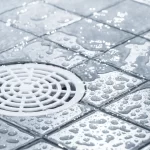We handle a lot of kitchen plumbing problems, most of the time we are dealing with a clogged sink. Unlike many plumbing issues, unclogged sinks are often something you can do yourself without too much know how, or really any wrenches or tools. A sink clog is often the result of built up gunk in the plumbing, so there are a couple of ways you can unclog the sink on your own. Here are two major DIY drain cleaning methods our Toronto plumbing team knows of that require little to no know how of plumbing.
Method #1: The Plunger
The plunger method is the most popular and probably the most familiar for people, it’s essentially doing what you do to a clogged toilet, but in your sink.
Step 1: Clean your plunger. A plunger that spends most of its time in a dirty toilet is not worthy to go in your kitchen sink, so make sure you give it a thorough clean before you begin.
Step 2: Put on the kettle. You’ll need boiling hot water, enough to partially fill your sink, before you start applying some elbow grease in the form of some serious plunging. Hot water helps clear drains better than cold water, so throw on the kettle.
Step 3: If you have a double sink, block up the other drain, that way the pressure and water will all head towards the clog rather than straight out the other pipe.
Step 4: Pour in the water and get to plunging. This is the easiest part, just start plunging the sink until the water drains through, just like a toilet. Be carful not to splash the water up, it’s literally boiling hot.
Method #2: Baking Soda and Vinegar
Every elementary student’s favourite science experiment can actually help with your clogged pipe. Unlike Draino and other pipe cleaner solutions, baking soda and vinegar are safe for the pipes, which can weaken if exposed to other chemical solutions too often.
Step #1: Clog the other sink if you have one, this will keep the vinegar and baking soda solution focused on the clog rather than spraying up the other side.
Step #2: Pour baking soda down the sink. Put in a healthy amount and make sure it goes all the way in. Use a spatula to push any extra baking soda down the sink.
Step #3: Ready the plug and vinegar. Just as you’re about to pour the vinegar down, get the plug ready because this stuff will spray up. Quickly pour a healthy amount of vinegar into the sink and put the plug in. The chemical reaction will be forced into the clog itself and will hopefully clean it out.
Step #4: Wait about 20 minutes and then pour hot water down the sink. If the clog is still there, try the whole process over again. It may take a few tries to loosen up all the dirt.
Both of these methods can take care of the majority of sink clogs in your home, but like many other plumbing issues, prevention is preferable. Sink traps are the best way to keep most gunk out of your sink and are easy to install. With these, you can prevent most clogs before they happen. But keep in mind that these methods aren’t always successful. If a clog persists, there may be larger issues that require a plumbing professional. Before you decide to take apart your sink, consider calling a local Toronto plumber to help you.






